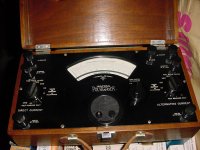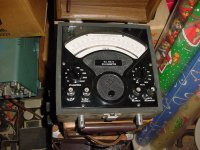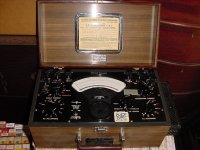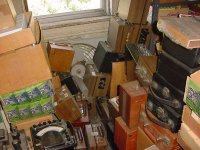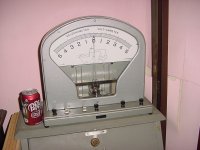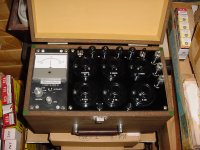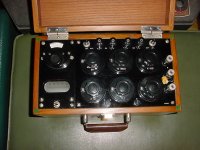> measure resistors already in a circuit
In-Circuit requires that you know a lot about the surrounding circuit; usually far easier (less brain-pain) to just unsolder one leg.
> measure dc resistance in tranformers and chokes.
In audio, it just is not necessary to measure that even as good as a $10 trailer-light meter can read. With transformers, short the winding you are not measuring; this kills 99% of the inductance (which will confuse DMMs) and kick-back. (Can't do this on a choke, though if you can get a fat wire around that might reduce inductance.)
Bridge techniques were invaluable before good meters, but are today just collectable objects.
In-Circuit requires that you know a lot about the surrounding circuit; usually far easier (less brain-pain) to just unsolder one leg.
> measure dc resistance in tranformers and chokes.
In audio, it just is not necessary to measure that even as good as a $10 trailer-light meter can read. With transformers, short the winding you are not measuring; this kills 99% of the inductance (which will confuse DMMs) and kick-back. (Can't do this on a choke, though if you can get a fat wire around that might reduce inductance.)
Bridge techniques were invaluable before good meters, but are today just collectable objects.
> measure dc resistance in tranformers and chokes.
In audio, it just is not necessary to measure that even as good as a $10 trailer-light meter can read. With transformers, short the winding you are not measuring; this kills 99% of the inductance (which will confuse DMMs) and kick-back. (Can't do this on a choke, though if you can get a fat wire around that might reduce inductance.)
Bridge techniques were invaluable before good meters, but are today just collectable objects.
I keep reading that accuracy is not "critical" in audio tube circuitry. My feeling is that accuracy doesn't hurt. So if available, I will spend a few extra cents for 1% metal film resistors if available.
However, I may be placing too much emphasis on accuracy tolerances of multimeters. I understand that digital has higher resolution, but I believe that a good vintage analog can be accurate, more consistent, be repaired and better quality that can last generations.
Does this belief go against scientific fact? I'm I using an inaccurate belief as a way to justify the feeling of using vintage equipment.
If tube audio circuits do not require the accuracy of Nasa equipment, then I should accept that choosing between a digital and analog multimeter can be just a matter of preference so as long as it has a 20,000/v or higher impedance.
Analog does have its advantages in measuring potentiometers
I've always had an admiration and affinity for old lab analog instruments. I have collected quite a few of them over the years. Mainly from Government sales or hamfest flea markets. Several SR poly-rangers and ESH high voltage meters. Weston's, Hickok's and Leeds & Northrup's as well. The only ones I use today are the HV meters, big and small. My favorite is the big classroom meter.The best movements were made by Sensitive Research. They still exist in a new form and are still the source for electrostatic voltmeters. They made meters with .1% accuracy which had 10" long mirrored scales for lab use. They even made a "universal meter" Sensitive Research Universal Poly ranger Model USP 28 Ranges AC - DC
It is a wonderful collectors item. It even has a thermal converter for accurate RMS measurements. The scales were all hand drawn. However these are not general purpose service instruments.
Attachments
Last edited:
I've always had an admiration and affinity for old lab analog instruments. I have collected quite a few of them over the years. Mainly from Government sales or hamfest flea markets. Several SR poly-rangers and ESH high voltage meters. Weston's, Hickok's and Leeds & Northrup's as well. The only ones I use today are the HV meters, big and small. My favorite is the big classroom meter.
It seems the Sensitive Research and other lab meters are all 1000 ohm/volt.
I'm not sure why that is... but I would think they would be more sensitive.
My understanding is the following example...Please correct me if I am wrong on this-
You need to take a reading of the voltage from a 600 ohm cathode resistor for a pre-amp tube. plan to use the volts and resistance to calculate the current.
I use a meter with an impedance of 1000 ohms/v and get a 3vdc reading.
This means that the meter is a 3000 ohm impedance with a 3vdc reading.
3V/600 ohms = 5mA
but the meter at 3000 ohm = 3V/3000 ohm = 1mA lost to voltmeter
and 600 Ohm x 1mA = .6V lost to the voltmeter
Does this mean the true figures are
3V -.6V = 2.4v and 5mA - 1mA = 4mA
Now if it is a 20,000 Ohm impedance, a 3v reading would create 60K ohms
3/600 ohms = 5mA
the meter at 20 kohms = 3/60,000 ohms = .05 mA
5mA - .05 mA = 4.95 mA
600 ohms x .05 mA = .06V
True readings would be
2.94v
4.95mA
So the due to the impedance the 20 Kohm meter is 2% volts off which means the mA is off 1%
The 1 kohm meter is off 20% volts off and mA is 20% off
So as stated and known, higher impedance is better. But I have seen from some specs. that lower impedance is more accurate...
some meters have 0.2% at 1000 ohm/v vs. 2% from 20,000 ohm/v
Now that I've gone through this journey in mathmagic land- if the math is done...would lower impedance give more accurate results?
> I use a meter with an impedance of 1000 ohms/v and get a 3vdc reading.
This means that the meter is a 3000 ohm impedance with a 3vdc reading.
Actually: you would probably use a 5V or 10V scale to cover 3V. So the loading is 5K or 10K.
Still very significant.
I don't think such fancy meters would be used for mundane tasks like tube cathode current.
> would lower impedance give more accurate results?
As I think I said: *good* amplifiers revolutionized metering. Asking a low power circuit to do its job AND push a needle against a spring is loading-error. Ask the low-power circuit to push, say, a TL071's FET input, to drive the needle (which can be 10+mA if desired). Now the error can easily be 0.005V (un-trimmed) plus movement error. The loading error is maybe 10Meg against 600r (<0.01%) plus 5mV against 3V (<0.2%) plus meter movement error (larger than loading error). And this is a 19 cent amplifier. The input offset can be trimmed far lower, factory trimmed really better than the user can do it. TL071 can use much more than 10Meg to hold its input when not metering, but even lower input currents can be bought.
This means that the meter is a 3000 ohm impedance with a 3vdc reading.
Actually: you would probably use a 5V or 10V scale to cover 3V. So the loading is 5K or 10K.
Still very significant.
I don't think such fancy meters would be used for mundane tasks like tube cathode current.
> would lower impedance give more accurate results?
As I think I said: *good* amplifiers revolutionized metering. Asking a low power circuit to do its job AND push a needle against a spring is loading-error. Ask the low-power circuit to push, say, a TL071's FET input, to drive the needle (which can be 10+mA if desired). Now the error can easily be 0.005V (un-trimmed) plus movement error. The loading error is maybe 10Meg against 600r (<0.01%) plus 5mV against 3V (<0.2%) plus meter movement error (larger than loading error). And this is a 19 cent amplifier. The input offset can be trimmed far lower, factory trimmed really better than the user can do it. TL071 can use much more than 10Meg to hold its input when not metering, but even lower input currents can be bought.
> choosing between a digital and analog multimeter can be just a matter of preference
No. You need *three* meters on your bench and ready to work.
No meter does everything well.
For trends or wobbles, a needle meter shows trends much better than flickering numbers.
For reading power tube current on a 1 Ohm cathode resistor, a $4 DMM will read 40mV with good accuracy, most needle meters will hardly budge off the pin and need serious squinting to get a wild guess.
OTOH, above 300V or 600V is un-safe for most digital meters. Passive meters tend to be limited by finger-safety issues (bare pin-plugs no longer allowed for HV) rather than risk of HV biting the logic chips.
My own preference would be:
classic VTVM - good needle, multiple functions, low loading, accuracy enough (after checking against a.......)
good DMM - Fluke (or similar; Beckman made a lot of fine bench meters). Accuracy is pretty assured (not skewed by weak tubes, cheap trimmers, banged meter-magnet).
cheap DMM - because a man with 2 watches never knows what time it is. And the good meters may crap-out at a bad time. And because some work (particularly flame-test) may want to monitor multiple points at once.
No. You need *three* meters on your bench and ready to work.
No meter does everything well.
For trends or wobbles, a needle meter shows trends much better than flickering numbers.
For reading power tube current on a 1 Ohm cathode resistor, a $4 DMM will read 40mV with good accuracy, most needle meters will hardly budge off the pin and need serious squinting to get a wild guess.
OTOH, above 300V or 600V is un-safe for most digital meters. Passive meters tend to be limited by finger-safety issues (bare pin-plugs no longer allowed for HV) rather than risk of HV biting the logic chips.
My own preference would be:
classic VTVM - good needle, multiple functions, low loading, accuracy enough (after checking against a.......)
good DMM - Fluke (or similar; Beckman made a lot of fine bench meters). Accuracy is pretty assured (not skewed by weak tubes, cheap trimmers, banged meter-magnet).
cheap DMM - because a man with 2 watches never knows what time it is. And the good meters may crap-out at a bad time. And because some work (particularly flame-test) may want to monitor multiple points at once.
Here is a site that will get you going : Randy and Sherry's Test Equipment
Higher accuracy would require higher torque to remove hysteresis from the movement. The Lab meters from SR had 12" long scales with interpolation. They were wonderful objects but not practical for daily use. They were used to check the accuracy of other meters. For perspective the .2% reading would be dividing a 10" scale into 500 parts or .02" divisions. That's about the pointer width of a typical meter.
The issue with tubes (and jfets) is the relatively soft numbers for voltage, unlike bipolar devices where the the E_B junction is .7V +/- a small amount. And for the most part getting a bias voltage or cathode current to 1% doesn't make a huge difference in the devices operation. An audio analyzer will get you much further in optimizing the performance.
Higher accuracy would require higher torque to remove hysteresis from the movement. The Lab meters from SR had 12" long scales with interpolation. They were wonderful objects but not practical for daily use. They were used to check the accuracy of other meters. For perspective the .2% reading would be dividing a 10" scale into 500 parts or .02" divisions. That's about the pointer width of a typical meter.
The issue with tubes (and jfets) is the relatively soft numbers for voltage, unlike bipolar devices where the the E_B junction is .7V +/- a small amount. And for the most part getting a bias voltage or cathode current to 1% doesn't make a huge difference in the devices operation. An audio analyzer will get you much further in optimizing the performance.
Thank you again all.
I haven't heard someone bring up the TL071 for a while now.
I used a TL072, It's a great chip.
The VoltOhmyst took a fall from 2ft...and the plastic cover cracked and flew off. After it happened, along with many choice words, I actually thought about taking the meter off and use it to scratch build a transistorized Multimeter.... Then I thought I could just use a TL072 rather than separate transistors.
I used the TL072 in audio with good success. TI has a new model, I think it's TL0722... sounds amazingly clear and fast when used as a phono preamp.
I work with wood, and thought about scratch building a voltmeter and ohm meter...building into a nice durable hardwood casing. Also using precision resistors... and I could use an amplifier if I wanted... but I'm thinking getting an old military battlefield meter would be a good choice. Easy to repair. and I can learn more about it. I have the digital already... and I don't mind doing some math.
I haven't heard someone bring up the TL071 for a while now.
I used a TL072, It's a great chip.
The VoltOhmyst took a fall from 2ft...and the plastic cover cracked and flew off. After it happened, along with many choice words, I actually thought about taking the meter off and use it to scratch build a transistorized Multimeter.... Then I thought I could just use a TL072 rather than separate transistors.
I used the TL072 in audio with good success. TI has a new model, I think it's TL0722... sounds amazingly clear and fast when used as a phono preamp.
I work with wood, and thought about scratch building a voltmeter and ohm meter...building into a nice durable hardwood casing. Also using precision resistors... and I could use an amplifier if I wanted... but I'm thinking getting an old military battlefield meter would be a good choice. Easy to repair. and I can learn more about it. I have the digital already... and I don't mind doing some math.
The '071 became moot when the '072 got cheaper than the '071.
The '071 has input offset trim, but any place you'd be trimming an opamp you should probably be using a pre-trimmed chip.
A voltmeter *might* be a place to trim a '071, but there's usually a more fundamental place to zero-trim the whole meter.
So it was just a figure of speech. 99% of the time you'll use a '072 even if you need just one opamp.
I suspect "TL0722" is incorrect, but yes TI has spread the BiFET love to lower consumption, or higher precision, or less THD.... I can't keep up with the numbers.
The '071 has input offset trim, but any place you'd be trimming an opamp you should probably be using a pre-trimmed chip.
A voltmeter *might* be a place to trim a '071, but there's usually a more fundamental place to zero-trim the whole meter.
So it was just a figure of speech. 99% of the time you'll use a '072 even if you need just one opamp.
I suspect "TL0722" is incorrect, but yes TI has spread the BiFET love to lower consumption, or higher precision, or less THD.... I can't keep up with the numbers.
- Status
- Not open for further replies.
- Home
- Design & Build
- Equipment & Tools
- Are Vintage Analog Military Multimeters Any Good?
